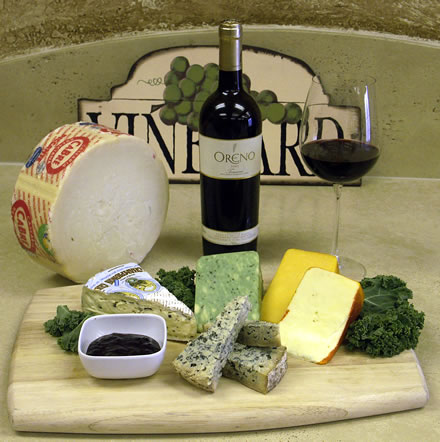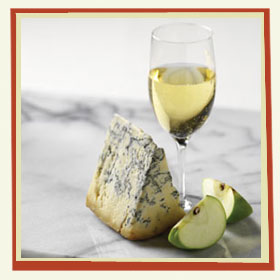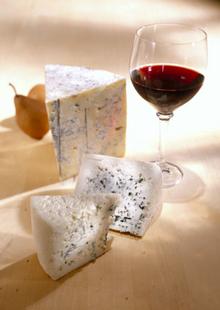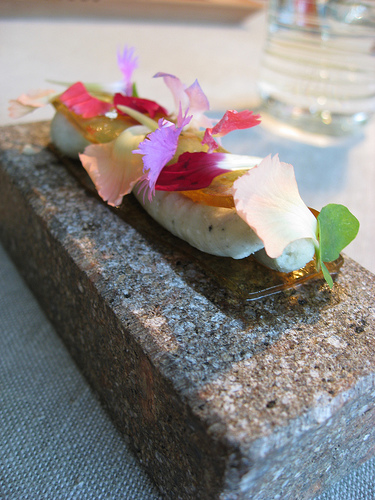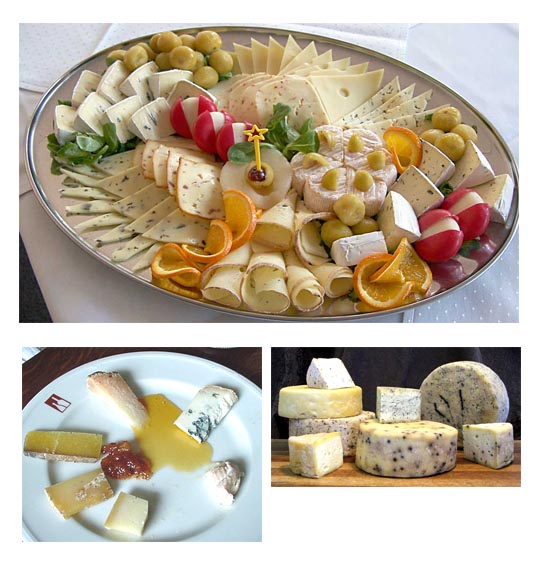The World of Cheese: Surefire Matches
Four distinctive cheese trays to showcase your favorite bottles
By Harvey Steiman
From Wine Spectator magazine,
According to common lore, matching wine and cheese is a no-brainer. But when a rich, plush red wine meets a fresh, tangy chèvre, it causes an unpleasant tannin explosion in the mouth. And a delicate red Burgundy can turn nasty against the mold taste and creamy texture of a Roquefort.
To find a good match for a specific cheese, focus on wines that can deal with the cheese's strong flavors or distinctive texture. Some famous matches provide clues: The goat cheese that kneecapped the plush red can make a tart, fresh white Sancerre or New Zealand Sauvignon Blanc sing like a warbling soprano. A sweet, luscious Sauternes will celebrate the Roquefort's pungency like a gospel choir at full volume.
The "classic" cheese plate—one fresh cheese, one hard, one blue, and one stinky and soft—doesn't work with wine. It's like trying to match one wine with oysters, fish, steak and chili.
The following pages suggest cheeses to serve with wines that Americans like to drink. For each category, I tasted several different wines with a range of cheeses, and have noted the best bottle. Wines with similar profiles should also work well with these cheeses. A Meursault, for example, behaved exactly like the California Chardonnay I suggest for the white wine plate, but cost twice as much, while an Oregon Pinot Gris proved not as versatile. Among reds, a Chianti Classico and Pinot Noir both did very well, but the Cabernet had the biggest wow factor. In the end, the wine and cheese matches with the most pluses on my scorecard made the final cut.
Food accompaniments add another piece to the puzzle and we give some suggestions, but fresh fruit generally can complement a variety of wines, as can nuts and olives (provided they're not too salty). Save the sweet condiments, such as dried fruit, honey and jams, for when you're drinking wines that are even sweeter.
You can test these suggestions or expand and adapt them to suit your preferences. But clearly, independent research is called for—perhaps at the end of your next dinner party.
WHITE WINE PLATE
White wines hardly ever clash with cheese, mild or stinky, soft or firm. Dry whites pair well with soft-textured cheeses, especially those with mild flavors, such as Brie. Whites with crisp acidity go particularly well with acidic goat cheeses. This cheese plate, which includes a Brie; two goat cheeses, Valençay and brunet; and a Gruyère-like Hoch Ybrig, emphasizes just how versatile white wines can be with cheese.
All of these cheeses fit seamlessly with the ripe, flashy Hanzell Chardonnay Sonoma Valley 2005. With a burst of pear, apple, melon and citrus flavors up front, the Hanzell announces itself as a California Chardonnay, but the lean frame and hazelnut and slate notes on the sleek finish made it behave with the cheeses the same way a Meursault that was tasted alongside it did.
The Valençay made the wine taste just gorgeous, bringing out its fruit without diminishing its minerality or racy acidity. Goat cheeses balance a wine's acidity with tartness of their own. The brunet made the wine more minerally and refined, a bit straighter in the backbone, which suggests that it would also make a good match with a more opulent Chardonnay.
The mild Brie hardly affected this wine at all, if any-thing making it seem more minerally and pure without eliminating a whit of its fruit. The stronger character of the Hoch Ybrig did the same, putting the wine's jazzier flavors into sharper relief.
Marcona almonds, which are rounder, sweeter and a bit more elegant than ordinary almonds, enhanced the wine's nutty flavors.
RED WINE PLATE
Red wines match up best with firm, mellow cheeses. Sheep's-milk cheeses with at least six months' age can produce the most pleasure with reds.
Carr Valley Marisa, an American sheep's-milk cheese aged for six months, has a rich texture but does not coat the mouth, allowing a red wine to express itself unimpeded. The cheese's nutty, earthy, vaguely herbal qualities complemented the ripe fruit and earthy, cedary character of Cabernet Sauvignon without getting in the way of its personality.
The smooth texture of Cliff Lede Cabernet Sauvignon Stags Leap District 2005 carries layers of currant, loamy earth and creamy oak flavors. After a bite of the sheep's-milk cheese, the wine just exploded with flavor, yet it retained all of its structure, getting more complex, deep and expressive. Other firm-textured cheeses, such as Spanish Manchego, made the wine seem richer and more opulent; the fruit and spice flavors dazzled.
Hard cow's-milk cheeses also did well here, such as Vella's crumbly Dry Jack and the brittle-textured Roomano, which is like an aged Gouda from the Netherlands. With the Jack, the Cabernet got very focused, the texture silky, the dark fruit coming to the fore.
The Roomano emphasized the tannins a bit, but made the flavors sail and evolve in the mouth. Beware of softer-textured cheeses, which can make red wines taste thin and can emphasize the tannins. Strong flavors tend to defeat red wines, tart goat cheeses can simplify them, and washed-rind cheeses and blues compete harshly with their flavors. With red, go for mellow.
Olives played well with these cheeses and reverberated with the savory flavors in the wine.
SWEET WINE PLATE
Just as fruit, honey and jam taste so good with cheese, sweetness in a table wine makes it match with a tremendous range of cheeses. Lusciously sweet wines, such as Sauternes, can stand up to even the strongest flavors and gooiest textures.
Sauternes is a classic match with Roquefort, the creamy French sheep's-milk blue cheese. In this tasting, Château Lafaurie-Peyraguey Sauternes 2005, with its layers of complex fruit flavors, made magic. It swirled its sweetness with the earthy mold character of the cheese—a case of creaminess trying to outdo even more creaminess. The results can spin your head.
Valdeón, another blue cheese, turned the wine match in a slightly different direction. Saltier than Roquefort and made predominantly from cow's milk, this Spanish cheese is wrapped in sycamore or chestnut leaves for aging, which adds another layer of flavor. It emphasized the fig and cream flavors in the Sauternes as the wine washed over it, a refreshing effect.
Washed-rind cheeses, which have a meltingly soft texture and complex earthy flavors that stem from an external mold, also find their best matches with sweet white wines. Cowgirl Creamery Red Hawk, with a distinct red tinge to its rind, focused like a laser on the fig and cream flavors and made the wine seem richer. Jasper Hill Farm's Winnemere, which can get as runny and stinky as Époisses, brought out a nice honey note in the wine.
Sweet Rieslings, such as German auslesen, behave differently with these cheeses but are just as appealing. Their acidity makes them more refreshing than what you get from the rich texture and heft of a Sauternes.
Fresh fruit, such as pears or cherries, rounded out this cheese-and-wine pairing. If you prefer dried fruit, make sure the wine is at least as sweet.
PORT WINE PLATE
There's a reason the English upper class finish fine dinners with Port and cheese, typically a Stilton or farmhouse Cheddar. Some cheeses deliver so powerful a punch that they require a wine that can push back effectively.
Stilton, which has a dry, austere edge that sets it apart from other blue cheeses, and Cheddar, which has a characteristic bitter bite hovering around the earthy flavors, bring out the best in a sweet wine. And if that sweet wine has the extra body of a fortified wine, such as Port, it produces a classic match. In this case, the austerity in a Colston Bassett Stilton played against the Port's sweetness to let Delaforce Ruby Port Fine NV express its lovely plum, cherry and spice flavors intensely.
The hint of caramel on the wine's finish also balanced the bitterness of the Quickes Traditional Farmhouse Cheddar. That cheese took some of the sweetness from the Port, but it let the wine's flavors sail effortlessly.
Bleu d'Auvergne has a stronger flavor than Stilton, and it's creamier, which makes for an even silkier match. The Port's alcohol came through a bit more with it, though.
Parmigiano-Reggiano, the classic Italian hard cheese often grated on pasta, tastes wonderful on its own. It's especially good with a touch of sweetness, often served with a drizzle of honey (especially truffle honey), and it came off as especially opulent with the Port.
Rich, sweet Medjool dates served as a perfect foil for all these cheeses, and they took nothing away from the richness of the Port.
Originally printed in Wine Spectator magazine, September 30, 2008 issue
http://www.winespectator.com/Wine/Archives/Show_Article/0,1275,6695,00.html
'Life > e—nouvelle—nouveau' 카테고리의 다른 글
| The 10 Eco-Best Fish (0) | 2008.10.04 |
|---|---|
| The 10 Eco-Worst Fish (0) | 2008.10.04 |
| America's Worst Breakfast Foods (0) | 2008.09.26 |
| Buttermilk Burrata (0) | 2008.09.19 |
| 갈비찜 Galbijjim (0) | 2008.09.03 |
